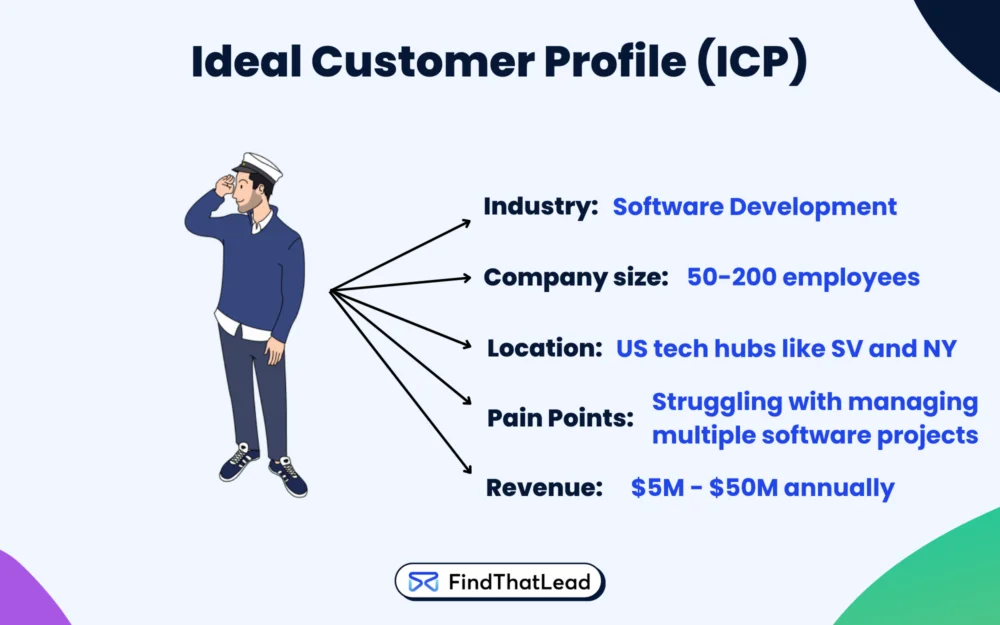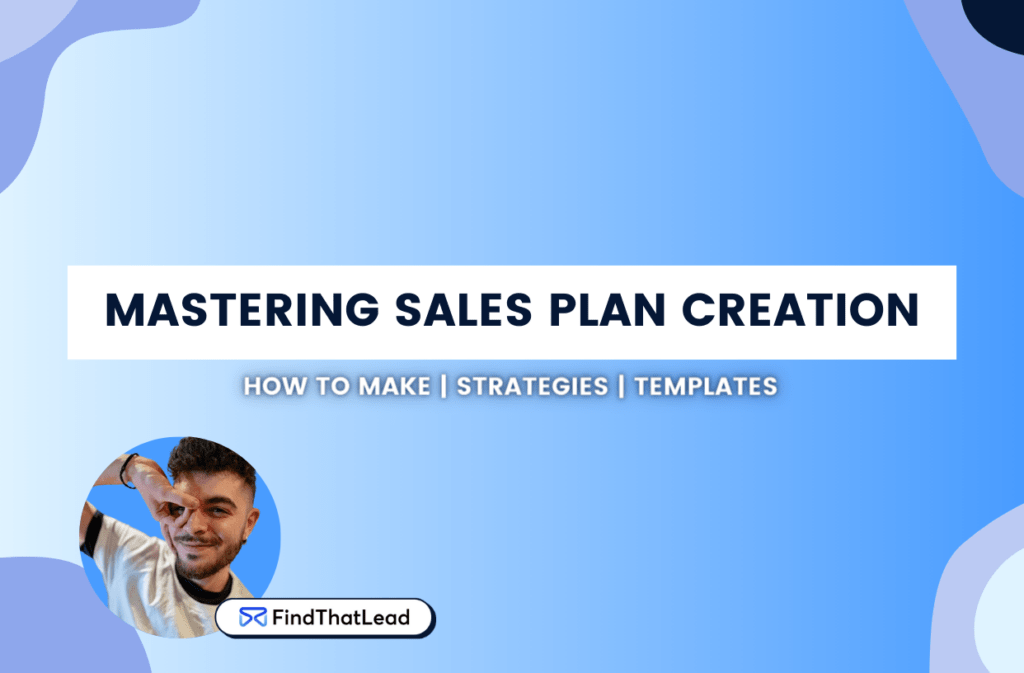Selling without a plan is like going to war without a strategy.
Can you do it? Yes.
Is it effective? No.
I’m speaking from experience, you can be very good at selling, but if you don’t know what you’re doing or where you want to go, you’re not going to achieve all that you could.
Stress, demotivation, feeling lost, lack of communication will all emerge…
And that’s solved with a sales plan.
Shall we start?
What is a Sales Plan?
Starting with the pure definition, what is a sales plan?
We can say that a sales plan is a document that outlines the entire sales strategy of a project, from processes and people to objectives and expected results.
There are a few key elements that can appear in a sales plan, not all are mandatory or necessary, but these are the most “standard” ones:
- Sales Goals
- Past performance
- ICP
- Segmentation strategies
- Market conditions
- Budget
- Sales tactics
- Individuals and teams
- Performance criteria & analytics
Crafting your sales plan: a step-by-step guide
I promised you that by the end of this post you would know how to craft a sales plan, and a promise is a debt, so let’s get to it:
1. Setting clear sales goals and examples
First things first, setting clear and measurable objectives is the critical first step in creating any plan, not just a sales plan.
If you are in the world of business/sales/marketing, what I’m about to tell you will sound familiar:
The best framework to work with objectives is SMART: [S]pecific, [M]easurable, [A]chievable, [R]elevant, and [T]ime-bound
- Specific: Objectives must be clear and precise so that the whole team understands exactly what is expected of them. And, of course, an example makes everything better: Instead of setting the objective as “increase sales”, it’s much better to set “increase sales of product X by 20% in the next quarter”.
- Measurable: You need to have a QUANTITATIVE way to measure success. Let’s take advantage of the previous example: “increase sales of product X by 20% in the next quarter”, the 20% is key here.
- Achievable: Objectives need to be realistic, for me, this is the most critical step, and I’m really telling you. Finding the balance between objectives that are too high that they demotivate and objectives that are too low that they do not push us to the maximum is a challenge in itself.
- Relevant: Objectives need to align with your company’s goals, it’s no use measuring your Twitter followers if it’s a channel that you do not use, for example.
- Time-bound: Every objective must have a clear timeline, and we return to the previous example: “increase sales of product X by 20% in the next quarter”.
2. Analyzing past performance
The next step is to analyze past performance.
What worked well?
What did not work?
Let’s see how we can do it:
- Identify patterns and trends: If you review your previous sales strategies, you can get an idea of how everything goes according to trends, temporalities… Look at how your business works during special dates like summer, Christmas, or Valentine’s Day.
- Learn from failures: If you fail you learn, your work is not a failure if you can find out why something has not worked, but of course, you have to be able to do it, that’s the challenge.
- Establish Benchmarks: The analysis of past performance allows you to establish reference points (benchmarks) for your future sales strategies.
3. Defining your ideal customer profile
I am insistent on this, but I am because it is important: the so-called “ICP“ Ideal Customer Profile, if you do not know 100% who you are selling to, how are you going to know how to sell to them? Let’s look at a few points:
- Demographic analysis: What is their age? Where are they from? What is their level of income or education?
- Behavioral study: What channels do they use to buy? What are their consumption habits? What motivates them to choose your product over others?
- Psychographic segmentation: Identify the values, interests, personalities, and lifestyles of your customers.
- Needs and pain points: What are the problems or needs that your product or service solves for your customers?
For example, if you identify that your ideal client is a young urban professional interested in technology, you can focus your campaigns on digital platforms and messages that have to do with innovation.

4. Effective customer segmentation strategies
If you have already created the ICP mentioned above, let’s move on to the next step, very much linked to the above, it is basically making sure that you are communicating with the right audience in the most effective way. How do we segment?:
- Demographic segmentation: One of the most basic and at the same time strong forms of segmentation. Divide your audience according to their age, gender, income level, education, and other demographic attributes.
- Geographical segmentation: Segment your customers based on their location. It can be as general as by country or as specific as by neighborhood. Very useful for personalizing messages and offers based on local needs or cultural features.
- Psychographic segmentation: Goes beyond the superficial and seeks to understand the personality, values, attitudes, interests, and lifestyles of your customers. This can help you create messages that resonate emotionally and are more persuasive.
- Behavioral segmentation: Here you segment customers based on their interaction with your brand, their purchase patterns, purchase history, response to previous campaigns, etc.
- Need-based segmentation: Identify different needs within your customer base and segment according to the solution that your product or service provides.
5. Adapting to market conditions
All I have to say here is that you take advantage of market conditions, adapt like a chameleon. I like examples, like Ikea.
Ikea has taken advantage of VR innovations in Meta with devices like Oculus. And they have improved the way customers interact with their products, apart from that they are already positioned as innovators.
They offer an application that allows users to see products in their own spaces, it was about helping to make decisions for their customers, and they have done it in a super effective and satisfactory way.
6. Budgeting for success
We are talking about intelligently allocating your resources and not at random. Every coin you invest should give a return.
In the context of a sales plan, budgeting is about how much money you assign, how and where you invest it.
We can take as a reference a technology company that invests in CRM (Customer Relationship Management) tools to improve the efficiency of its sales team. Yes, a type of investment that is expensive at first, but by improving customer relationship management, the company can increase its sales and customer loyalty, and in the long run, you win.
And this is not only about investing, it’s also about being able to reduce costs in the areas where it has to be done.
7. Strategic sales tactics and implementation
It’s about capturing the essence of how you present your information: Concrete action.
For example, if a company decides to implement a sales tactic based on personalizing customer contact, don’t leave it in theory. It means that from the sales representative to the CRM software, everything must be aligned to gather info from each customer interaction and use it.
Or suppose you decide to implement an upselling and cross-selling strategy. It implies integrating this tactic at every point of customer contact, from the web to after-sales service.
The implementation must be practical and measurable. You can have the best ideas in the world, but if you are not capable of executing them, they are absolutely worth nothing
8. Individual and team action plans
Here we go full throttle. When you organize your sales team, each member needs to know exactly what is expected of them.
In addition to assigning territories or clients, each member needs to be aware of their specific goals, tasks, roles, and how they contribute to the objective.
A sales team is a team, there may be roles that should not overlap, specializations, etc…
An Appointment setter is not the same as an SDR, or a closer, for example.
The key is in clarity and communication. Each team member must have an action plan that details their objectives and responsibilities, how and when they will be evaluated.
9. Setting performance criteria and analytics
Now, how do you know if everything is going well? You need metrics, indicators that tell you if you’re heading in the right direction. But also don’t track irrelevant data. Focus on metrics that matter.
For example, if your strategy is focused on acquiring new clients, a key metric could be the number of new clients per quarter.
These metrics should be clear to everyone on your team and reviewed regularly! If something doesn’t work, adjust. If something is going well, analyze why and look to scale.
Utilizing sales plan templates and examples
Yes, we are not going to leave here without a sales plan template that you can use right away, a template is something very general and I will always recommend that you personalize it and make it as specific as possible for you, here we go:
Sales Plan Template
1. Setting Clear Sales Goals and Examples
SMART Objectives (Checklist):
- Specific:
- Measurable:
- Achievable:
- Relevant:
- Time-bound:
Examples of well-defined objectives:
2. Analyzing Past Performance
Summary of past performance:
Lessons learned:
Opportunities identified:
3. Definition of the Ideal Customer Profile (ICP)
Demographic data:
Buying behavior:
Needs and preferences:
Pain points:
4. Effective Customer Segmentation Strategies
Segmentation criteria:
Description of segments:
Strategies for each segment:
5. Adapting to Market Conditions
Market trends:
Opportunities and threats:
Adaptation strategies:
6. Budgeting for Success
Total budget:
Distribution of the budget by activity:
ROI tracking:
7. Strategic Sales Tactics and Implementation
Description of tactics:
Implementation plans:
8. Individual and Team Action Plans
Roles and responsibilities:
Objectives of the individual and the team:
Action plans:
9. Establishment of Performance Criteria and Analysis
Key KPIs:
Analysis and evaluation methods:
Performance-based adjustment plan:
There are tools like HubSpot, Smartsheet, or Salesforce that include sales planning sub-tools and can help you a lot in achieving your objectives.
Choosing the right sales plan for your business
What sales plan is the best for me? How do I personalize my template? I give you some extra keys so that you can do it:
- Understand your own product
What product do you offer? What problem does it solve? Who does it solve the problem for? What are its threats and advantages? Environmental analysis? What works for one may not be effective for another.
- Evaluate your Resources
Analyze the resources available: sales team, technological tools, and budget. The plan you choose must be realistic and executable with the resources you have.
- Implementation and Monitoring
Choose a plan that you can implement effectively and that allows you to track progress towards your objectives. It should include clear metrics and control points to assess success and make the necessary adjustments.







 BONUS:
BONUS: The Challenge: Join this free course and I guarantee that after 5 days you will have the necessary skills to start generating B2B clients Growth Hacking and Prospecting techniques.
The Challenge: Join this free course and I guarantee that after 5 days you will have the necessary skills to start generating B2B clients Growth Hacking and Prospecting techniques.